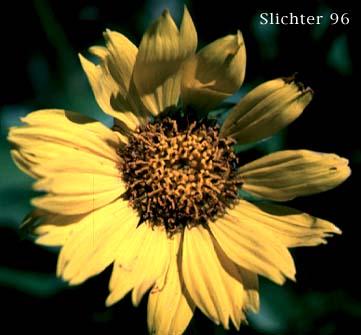 Characteristics:
Characteristics:
Northwest balsamroot is a perennial with a deep, woody taproot. The basal leaves form a rosette, and are long-petiolate. The blade is mostly triangular-hastate, and may have a cordate base. The leaves are upt to 30 cm long and 20 cm wide. The leaf surfaces may be glandular as well as occasionally rough-haired. The leaves are generally green in color, and less hairy than arrowleaf balsamroot (Balsamorhiza sagittata). The leaves tend to be thinner and less veiny than those of the similar Carey's balsamroot (Balsamorhiza careyana).
The stems are 20-100 cm tall, usually with several very reduced narrow leaves. There may be one to several flower heads atop the stem. The central one is largest, with the lateral heads reduced in size. The disk of the central head is rarely less than 2.5 cm wide. The rays usually number 13, but there may be as many as 21 present. The rays of the larger head range from 2-5 cm long, and they are soon deciduous (dropping off), as compared to Carey's balsamroot where they persist. The involucre is only slightly woolly, with the outer bracts being very large and leaf-like, often surpassing the disk (The outer bracts of Carey's balsamroot are roughly of equal size to the inner bracts.).
Northwest balsamroot may be found in deep prairie soils.
Northwest balsamroot may be found in thePuget Trough from southern Vancouver Island south through western Washington and Oregon to southern California.